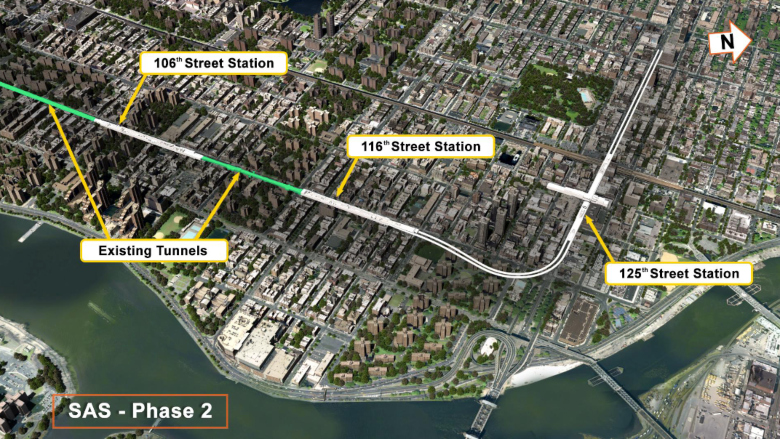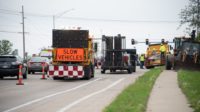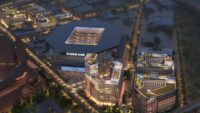New York’s Metropolitan Transportation Authority anticipates beginning construction on Phase 2 of its Second Avenue subway line into Manhattan's East Harlem section next year, as long as expected federal funding arrives, according to Charles Gary, deputy general counsel at the transit agency.
This phase of work in the four-phase plan would extend MTA’s Second Avenue line 1.76 miles from 96th Street to 125th Street and add stations at 106th, 116th and 125th streets. The total capital cost is estimated at $7.7 billion, according to Federal Transit Administration records.
Gary, speaking at an eminent domain public hearing March 15, outlined MTA’s plan for this piece of the project. Construction of this phase would be broken up into four contracts, he says. The first contract would cover early works and utility relocation, records show. MTA says it plans to solicit that work within the next few months, with a cost estimated between $25 million and $100 million.
MTA also says it expects to solicit a design-build contract for tunnel boring and cavern work sometime this year. According to Gary, the second Phase 2 contract will include tunnel boring machine construction between 115th and 125th streets, and west along 125th to a point between Malcolm X Boulevard and Adam Clayton Powell Jr. Boulevard. That contract would also include restoration and conversion of an existing tunnel for the 116th Street station and cavern mining for the 125th Street station.
The scope of the third contract would include cut and cover construction of the 106th Street station structure and connections for two tunnel sections built as part of an incomplete 1970s project, plus station entrances and connections to two ancillary buildings, Gary says.
The final contract would cover construction of five ancillary buildings, station entrances, fit-out of stations and tunnels, MEP work, architectural finishes and the installation of tracks and signal systems.
A joint venture of WSP and STV has been working on preliminary engineering and design for Phase 2.
Under the proposed financial plan, the Federal Transit Administration would cover 49% of the project’s cost, about $3.4 billion. President Joe Biden’s 2024 budget request recommends $496.8 million for the project in the next fiscal year. FTA Administrator Nuria Fernandez, in a statement about funding recommendations for this and 17 other large transit projects in Biden’s budget, said every federal dollar would result in $5 or more of economic growth.
“For the men and women who will use these systems, this investment will open doors to opportunities they may otherwise never have had,” Fernandez says.
 Plans for Phase 2 of the Second Avenue subway project call for tunnel segments built in the 1970s to be adapted for use. Photo by Marc A. Hermann/MTA
Plans for Phase 2 of the Second Avenue subway project call for tunnel segments built in the 1970s to be adapted for use. Photo by Marc A. Hermann/MTA
The current cost estimate is up $558 million since MTA’s prior estimate in November 2019, which FTA officials say comes from an increase in unallocated contingency for project risks. Phase 1, which opened at the start of 2017 and earned an ENR Best of the Best nod for a transit project, cost $4.5 billion. With three stations along 1.8 miles, a recent New York University-led study identified Phase 1 as the most expensive subway build in the world on a per-kilometer basis.
There is a strong need for the extension into East Harlem, with a forecast of 123,000 daily linked trips in 2035, according to FTA. Gary says two East Side elevated train lines were taken down in 1942 and 1956, leaving the Lexington Avenue subway line alone to accommodate a growing population. Plans to build new subway lines did lead to construction of some tunnel segments, but the project was suspended because of the city’s 1970s financial crisis.
“The new line will make the neighborhoods of the East Side more accessible not only for those who live there, but to visitors and workers traveling from other parts of New York City as well,” Gary says.
With the planned third and fourth phases, the Second Avenue line would run 8.5 miles from 125th Street and Lexington Avenue in Harlem to Hanover Square in the Financial District.






Post a comment to this article
Report Abusive Comment